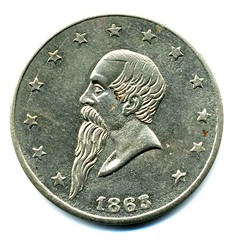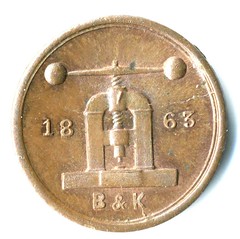
PREV ARTICLE
NEXT ARTICLE
FULL ISSUE
PREV FULL ISSUE
CIVIL WAR TOKEN MAKER RESEARCH HELP SOUGHTAuthor and researcher Q. David Bowers is hard at work on a new book, this one on the makers and sellers of U.S. Civil War Tokens. Can anyone help? Here's his summary of the needed information.
-Editor
I stand on the shoulders of those researchers who have gone before, plus a number of modern scholars who have contributed to a book that will include much never before in print in a single volume. The chapters on the larger companies are comprehensive—with S.D. Childs, William K. Lanphear, and John Stanton leading the field. In Connecticut the Scovill Manufacturing Co. made tokens in brass, but exactly which ones is a puzzle. More mysterious is the Waterbury Button Co., said to have made CWT, but no specific varieties can be attributed to them.  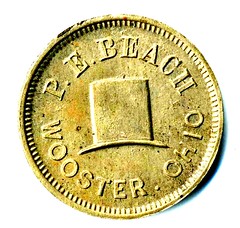 OH-975-A: P. E. Beach Over 60 different engravers, coiners, and distributors will have individual chapters. Among these, here are some mysteries for which little is known about the people involved and what they did, as little has been found beyond their advertisements. If any E-Sylum readers can help, I would be very pleased! Here is the list: C. Barkley and John Maloney both had the same NYC address. Were these real people or are the names pseudonyms? D. Mack is likewise mysterious—advertising at two NYC addresses and in Boston. Francis Smith Edwards, M.D. is famous in the literature of early American coins as a maker of counterfeits of numismatic rarities, but did he ever make any CWT?
Neal & Enscoe in New York City is a mysterious partnership, and little is known of A. Ogden and S. A. Ogden at two addresses in the same city. Charles F. Ulrick, Cincinnati engraver, was known to H.C. Ezekiel, who collected CWT in the 1860s, but I have not been able to learn anything about him. J.E. Valentine’s biography is elusive as well. 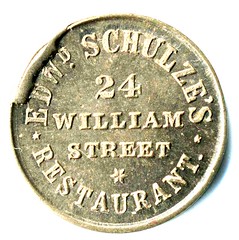 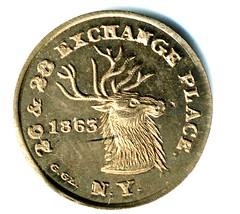 NY-630-BO: Edward Schultze's Restaurant Then there is the Wooster Street coiner mentioned in an article published in The Numismatist, November 1932. The writer, Joseph Barnet, lived in Brooklyn and was the foremost dealer in and advertiser of Civil War tokens at the time, wrote multiple articles on the subject, gave talks to coin clubs, and mounted displays. 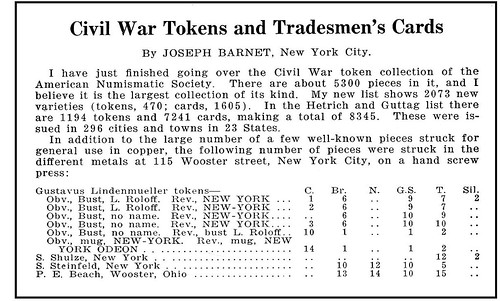 The vast majority of the ANS tokens came from the collection formed by Edward Groh, a pioneer enthusiast who obtained them at the time they were minted. The October 20, 1901, New York Times printed an interview with him in which he told of his collecting experiences over a period of decades, including this: During the Civil War Mr. Groh made his famous collection of copperheads which he has since presented to the New York Numismatic Society. There are about 3,500 pieces in all, representing every state, town, and business house in which such coins were issued. “It wasn’t necessary to approach a dealer for one of them,” said Mr. Groh. “I simply gathered specimens of those about me as they were issued, and I have corresponded and traded with collectors in all our Eastern towns and cities. Then after the war I traveled through the West, collecting and trading as I went. No, I don’t remember any remarkable experiences or histories concerned with them. There was very little of that sort of thing in coin collecting then.” The Society had information about the minting of certain varieties in addition to those “struck for general use” at an earlier time. Perhaps there was or is a note with some of these varieties given by a donor other than Groh. Earlier, some of these restruck token varieties had been issued in quantities of many thousands for circulation. It seems that the dies had come into the hands of an unknown numismatist at a later time, who took them to someone at 115 Wooster Street in Lower Manhattan and had additional pieces struck. At one time there was a brass factory there, but details of it have not been learned. The restriking may have taken place after the Civil War at when time the usual CWT shops in Manhattan were no longer active. 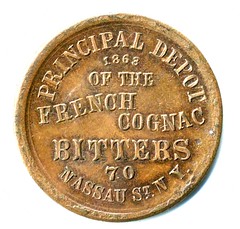 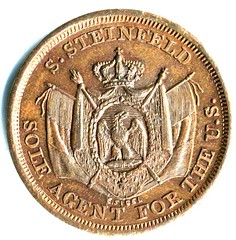 NY-630-BU: S. Steinfeld Relevant to the above, a give a nod to Julie Casey, David Gladfelter, John Ostendorf, and David Schenkman who in recent weeks have solved several mysteries. Now, it is goal to go! You can contact me:  Wayne Homren, Editor The Numismatic Bibliomania Society is a non-profit organization promoting numismatic literature. See our web site at coinbooks.org. To submit items for publication in The E-Sylum, write to the Editor at this address: whomren@gmail.com To subscribe go to: https://my.binhost.com/lists/listinfo/esylum All Rights Reserved. NBS Home Page Contact the NBS webmaster 
|
